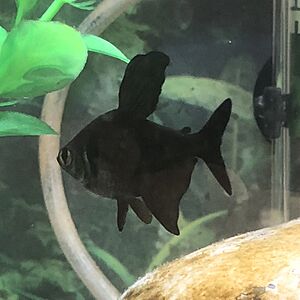Black phantom tetra facts for kids
Quick facts for kids Black phantom tetra |
|
|---|---|
 |
|
| Male | |
| Conservation status | |
| Scientific classification | |
| Synonyms | |
|
Megalomphodus megalopterus |
The black phantom tetra (Hyphessobrycon megalopterus) is a small, cool freshwater fish. It's also known simply as the phantom tetra. This fish is part of the characin family (Characidae). You can find them naturally in the upper parts of the Paraguay and Madeira basins. These areas are located in Brazil and Bolivia. Many people also enjoy keeping them as pets in their aquariums.
Contents
What Does the Black Phantom Tetra Look Like?
This fish has a body shape that is somewhat like a square. It is light grey in color. On each side, behind its gills, it has a black spot. This spot is outlined with a shiny, silver edge. The male fish have black fins. The female's dorsal fin (the one on top) is also black. However, the female's pelvic, anal, and adipose fins are reddish. Some black phantom tetras sold in pet stores have longer fins. These were likely bred by people who keep fish. The black phantom tetra can grow up to about 3.6 centimeters (1.4 inches) long.
How to Tell Male and Female Black Phantom Tetras Apart
Male black phantom tetras usually have longer fins than the females. When it's time for them to have babies, the females look a bit rounder. But the easiest way to tell them apart is by their color. Males do not have any red on their fins. Females, however, have red on their smaller fins, both on top and underneath their bodies.
The adipose fin, which is a small, fleshy fin behind the main dorsal fin, is much easier to see on females. This is because it's red on females but grey on males. The female's dorsal fin also has a darker black color than the male's. When these fish are ready to breed, their colors become even brighter. The male's black fins will look even more striking.
What Do Black Phantom Tetras Eat?
In their natural homes, black phantom tetras like to eat small crustaceans, insects, and worms. These are tiny creatures they find in the water.
Black Phantom Tetras in Your Aquarium
H. megalopterus is one of the most popular types of tetra fish sold for aquariums. They might not be the most colorful fish, but they are very interesting to watch. Male black phantom tetras like to have their own space. They will defend their area from other fish. They do this by showing off their bodies sideways, with their dorsal and anal fins spread out wide. Their dark colors become even darker, making the silver edge around their body spot really stand out.
Sometimes, they might even bump into each other. This can cause small tears in their fins, but these usually heal quickly. Unlike many other tetras that like to live in very big groups, black phantom tetras are happy in smaller groups of four or five. This makes them a good choice for smaller aquariums. However, they still need enough room for the males to claim their territories and show off.
Reproduction and Life Cycle
To encourage these fish to lay eggs, you should feed them well. Giving them live foods, like small worms, is very helpful during this time. Frozen foods, such as bloodworms, can also be used.
Black phantom tetras are "egg-scattering" fish. This means they scatter their eggs freely, rather than laying them in a neat nest. To help them breed, the water should be a bit soft and slightly acidic. The breeding tank should have plants, both rooted in the bottom and floating on top. It should also have dim lighting.
A female black phantom tetra can lay about 300 eggs. These fish will eat their own eggs and baby fish (called fry). So, it's best to remove the adult fish from the tank after they have laid their eggs.
Raising Baby Black Phantom Tetras
The baby fish, or fry, start swimming freely after about five days. At first, they are fed tiny living things called infusoria (which are very small organisms). You can also use special commercial foods made for fry, as long as they are the right size. Giving the young fish live food, even as they grow, is always good for them.
See Also
- Community fish
- List of freshwater aquarium fish species
Images for kids





